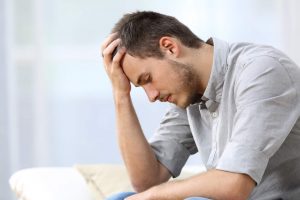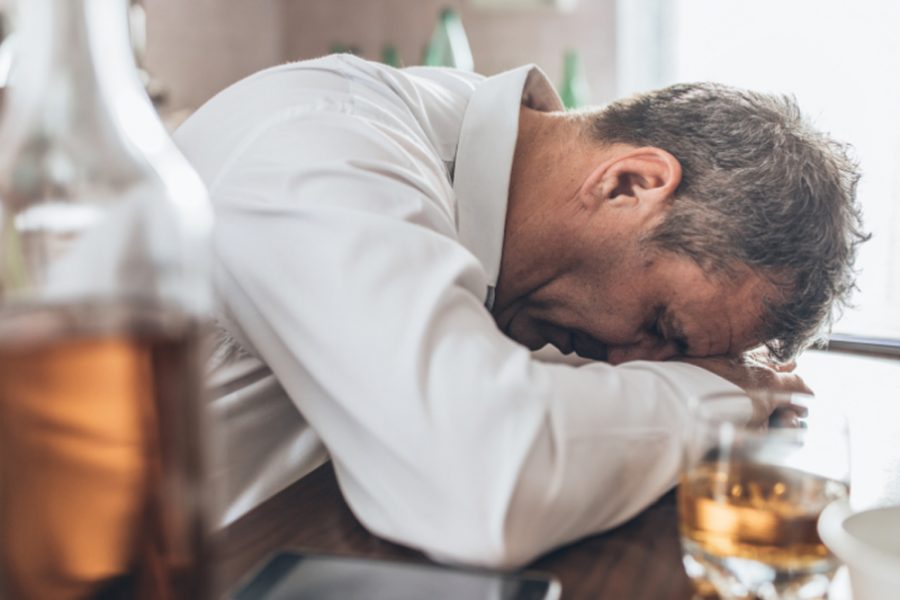Drinking alcohol in moderation should not pose any serious health problems. However, regular heavy drinking may cause your body to become dependent on alcohol. Any time you try to reduce your drinking or stop it altogether, you will experience alcohol withdrawal symptoms. These tend to be very uncomfortable, making it much harder to control your drinking habits.
What are the symptoms of alcohol withdrawal?
 Insomnia
Insomnia- Trembling
- Mild anxiety
- Headache
- Stomach upset
- Palpitations
- Excessive sweating
- Anorexia
- Hallucinations (visual, auditory, or tactile)
- Seizures
- Tachycardia (heart rate of over 100 beats per minute)
- High blood pressure
- Fever
- Agitation
- Disorientation
- Delirium tremens (DTs)
Mild symptoms, such as trembling, headache, and stomach upsets, generally happen within 6 to 12 hours of your last drink. Hallucinations and seizures can occur within 24 to 48 hours. The worst symptoms, such as delirium tremens (DTs) and intense hallucinations, may develop after 48 to 72 hours.
DTs constitute a medical emergency. Thus, if you or someone you know is experiencing this, call for medical help immediately. If DTs is not treated promptly, it may turn life-threatening.
What causes alcohol withdrawal?
 Alcohol interferes with the normal function of the brain. As a depressant, it slows down activity in the brain, promoting relaxation. If you drink frequently, your brain will soon become used to the effects of alcohol. Consequently, to keep the brain functioning, it will have to work harder to keep you alert.
Alcohol interferes with the normal function of the brain. As a depressant, it slows down activity in the brain, promoting relaxation. If you drink frequently, your brain will soon become used to the effects of alcohol. Consequently, to keep the brain functioning, it will have to work harder to keep you alert.
Once you cut down on alcohol or stop drinking, the brain is still in that hyperactive state. Without alcohol to slow the brain down, withdrawal symptoms like anxiety, trembling, restlessness, and seizures kick in. The cause is an overactive brain.
How is alcohol withdrawal treated?
Benzodiazepines are commonly used medications to treat withdrawal symptoms like seizures, insomnia, and anxiety. These drugs, also known as “benzos”, are central nervous system depressants. In other words, they slow down the activity of the brain, effectively calming you down. You may even feel drowsy or sleepy while taking benzos.
Both benzos and alcohol are depressants, and both have addictive potential as well. Benzos also carry other side effects, including dizziness, confusion, and muscle weakness. Thus, benzos need to be taken carefully and only with medical supervision to be effective.
Three benzos are often used in alcohol withdrawal treatment. These are:
- Chlordiazepoxide (Librium)
- Diazepam (Valium)
- Lorazepam (Ativan)
These drugs are tightly regulated, and you cannot get them without prescriptions. Thus, they are only used in proper treatment settings. These medications are often part of alcohol detox, which can either be inpatient or outpatient.
Inpatient rehab settings give the best results for detoxing with benzos. Here, you get 24/7 care from medical professionals, so in case you feel anything strange, uncomfortable, or painful, you can get help right away. But benzos have also seen success when prescribed in outpatient rehab programs.
Because of their potential side effects, the dosing of benzos need to be carefully monitored and controlled. Which benzo you will be given, and how much, depends on the withdrawal symptoms you have, the severity of your alcohol dependence, and whether you are in an inpatient or an outpatient rehab setting.
There are three methods mainly used when prescribing benzos for alcohol detox.
Symptom-Triggered Regimen (STR)
 In STR, your benzo dosage depends on how you rate your level of pain. If your pain rating is higher, you get a bigger dose. Several other criteria are also assessed before any medication is prescribed.
In STR, your benzo dosage depends on how you rate your level of pain. If your pain rating is higher, you get a bigger dose. Several other criteria are also assessed before any medication is prescribed.
For STR to work safely, you can only undergo this regimen in an inpatient rehab facility. You will need direct supervision from doctors and consistent monitoring.
The main advantages of STR is it shortens the length of treatment and lets you take less medication overall. The risk of under- or overmedication is also smaller.
Fixed Tapering Dose Regimen (FTDR)
In FTDR, your dosage is fixed regardless of the severity of your withdrawal symptoms. FTDR can be used in outpatient settings, as consistent monitoring will not always be required. Also, this regimen works best if you have mild withdrawal symptoms.
Also, as the name implies, your dose will be tapered down with time. Benzos are only temporary medications, as using them for a long time can lead to addiction.
Loading Dose Regimen (LDR)
LDR uses long-acting benzos, which stay in your body for several days. It works best in preventing seizures, and it is only done in inpatient rehab settings. Monitoring is important in LDR, so it cannot be administered in outpatient rehab programs.
Other medications
Aside from benzodiazepines, other drugs may also be used to manage alcohol withdrawal symptoms. Anticonvulsants like gabapentin and carbamazepine are also helpful, especially in preventing seizures. Additionally, some studies have shown that anticonvulsants can help with reducing alcohol cravings.
The good thing about anticonvulsants is their lack of addictive potential. With that, they are safer than benzodiazepines. However, using anticonvulsants alone may not be enough to effectively manage alcohol withdrawal symptoms. Thus, both kinds of medications may be used in combination.
Adrenergic drugs, like clonidine, are also used when detoxing from alcohol. These drugs lower your blood pressure and heart rate if they are high. Adrenergic drugs do not treat seizures or DTs, though.
Are medications always needed in treating alcohol withdrawal?
Medications are not always necessary. Before doctors prescribe you anything, they will assess your condition first. Not all cases of withdrawal warrant medication.
Doctors often use what is known as the CIWA-AR (Clinical Institute Withdrawal Assessment – Alcohol Revised) scale to find out how severe your withdrawal symptoms are. If you score zero to 8 points on this scale, medications may not be necessary for you. But if you score 9 and above, you will be prescribed medications.
If you do not need medication, supportive care will be given to you for up to 36 hours. After that time, it is highly unlikely that you will develop worse withdrawal symptoms.
To ensure that withdrawal does not bother you again, it is best to stay away from alcohol. Continuing to drink will significantly increase the chances that you will experience withdrawal again in the future.



 Infertility
Infertility When you drink, alcohol affects your pituitary gland and hypothalamus. Without GnRH, FSH, and LH, the testes cannot produce testosterone. Based on research, testosterone levels drop as quickly as 30 minutes after drinking.
When you drink, alcohol affects your pituitary gland and hypothalamus. Without GnRH, FSH, and LH, the testes cannot produce testosterone. Based on research, testosterone levels drop as quickly as 30 minutes after drinking. 12 ounces of beer (normally at 5% alcohol)
12 ounces of beer (normally at 5% alcohol)



